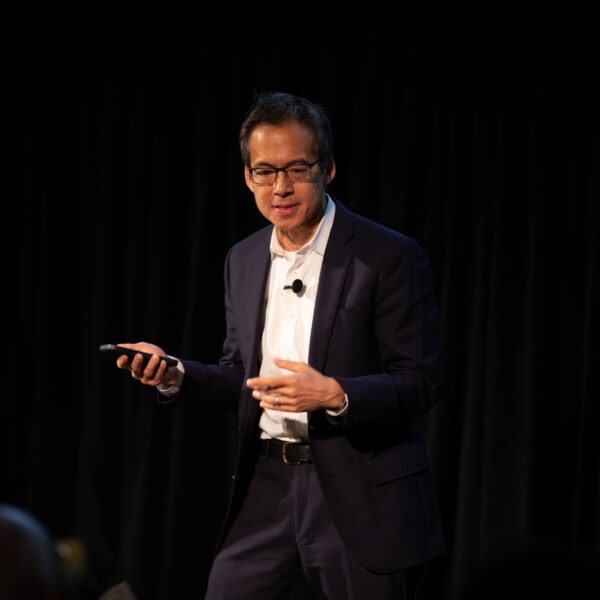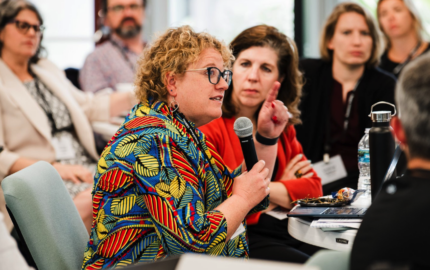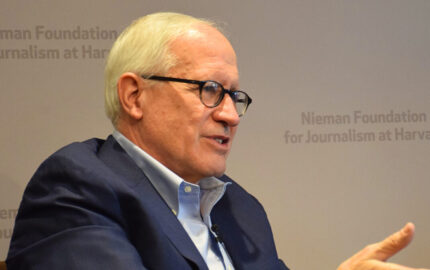The election of Donald Trump to a new term as president has underscored how politically divided Americans remain – possibly more than at any other time in the last 50 years, with a majority of both Republicans and Democrats viewing the opposing side as the biggest threat to democracy, various studies show. The polarization has undermined faith in traditional news media, in political conciliation and cooperation, and in the U.S. electoral system itself.
Archon Fung, the Winthrop Laflin McCormack Professor of Citizenship and Self-Government at the Kennedy School of Government at Harvard, spoke to this year’s Nieman Fellows and to Nieman Reports in October about the current state of America’s deep political divisions, shifts in our electorate, and ways of mitigating polarization during an election year and beyond. Edited excerpts:
One thing that’s quite different compared to 2020 is three or four out of every 10 Americans just do not believe that Joe Biden won the 2020 election. So election skepticism and doubt is a mass phenomenon, and public opinion is much, much wider than it has been, maybe ever, in American history. Another thing on the negative side is that at the more elite level of parties, campaigns, and election lawyering, the efforts to cast some doubt on the result of the 2020 election were kind of a dry run, and now people sowing that doubt … have a set of [more] sophisticated strategies.
I think that people have learned a lot, especially the secretaries of state and election administrators, about the real threat of political violence, how to defend against that, [and] strategies to instill more confidence in the election apparatus. In the run-up to January 6 and the effort to question the 2020 certification of electors in the Electoral College, nobody really expected that, or [knew] how to defend against it. Now, there’s a lot of people thinking about what the different avenues of attack might be.
So, I think at least in my lifetime, the level of political threat and violence and intimidation is just at a qualitatively higher level. It’s so much more widespread in the last four years. [In] surveys of election officials and election workers, something like three or four out of 10 said that they’ve experienced some kind of threat or intimidation, and many of those are leaving the job because of that.
I think in your journalism, you can see this, even if you don’t work in the political sphere. If you cover a city council meeting or a school board meeting, you will encounter lots and lots of hostility.
[People] need institutions that they can rely on. They need a working media. They need a working education system. They need reliable sources of information of all kinds. I mean, it [will] take a long time to get all the way there.
I think that a first step, though, is for all of us to be more open-minded about what’s true and what’s not. That’s why I don’t like the term “misinformation,” because it suggests that it’s pretty easy to tell what’s misinformation and then what’s true. I think the Covid experience just shows that’s not the case. I was making fun — just like everybody else in Massachusetts — of people not wearing masks and not wanting to social distance – I made fun of them as hating grandma and hating science. And that was just really, really wrong.
I don’t think it works to try to shove facts down people’s throats. A friend of mine who passed away was a health minister in England, and she said she spent a long time dealing with moms who were vaccine-hesitant. She said, “Look, you really have to start by listening.” If you’re a mom and your kid has autism, maybe you feel a great deal of guilt with regard to that. Maybe you’re trying to figure out why that happened. So I think you’ve got to try to meet people where they are and reason out from that.
In Maricopa County, Arizona, one of the best, most noble election directors in the country is Stephen Richer. And one of the things that he’s doing in his office is encouraging him and his staff to meet with election skeptics just over coffee and breakfast. You don’t talk about the election, you talk about your kid’s soccer game or whatever, just to begin to build some kind of tapestry, and then maybe you can deal with the election skepticism. And then maybe if things really, really go south in 2024, you’ll have a phone number to call and somebody doesn’t get killed.
I think the listening does help. In these bridge-building things, people form these relationships and these bonds that continue. They adopt some of the other positions and behaviors. One of the big groups in this space is Braver Angels. Another is More in Common, if you want to look into their work.
I think a particular pathology of the United States, which journalists and people at the local level and political scientists can’t do anything about, is the two-party system. It’s a lot easier, although still difficult, in our turbulent times, to depolarize if there’s more than two parties. If there’s three [or] four parties, political scientists call it crosscutting cleavages. There’s just more dimensions of play there. In the United States, there should absolutely be at least four parties, right? There should be a Biden traditionalist Democratic Party, there should be an AOC/Bernie party, there should be a traditional Mitt Romney/Liz Cheney Democrat-Republican Party, and there should be a MAGA Party. And if that were the political configuration, I think that would change all of the political reporting, because the campaigns would feel much different.
I think many analysts treat these agglomerations as much more uniform than they are, especially Latino voters, but also African American men, as you say.
But an important part of it is that the parties themselves are not what they used to be. Obviously, the Republican Party is not what it used to be, but I’m talking about in a much bigger sense, it is possible that … the policy positions of the traditional Republican Party and traditional Democratic Party will flip.
And so there’s a bunch of research, some of it by [French economist and academic] Thomas Piketty, that shows that in the United States and in Europe, one of the biggest cleavages now between the left and right populist parties is education. So, with higher education voters voting more Democrat in this case, it used to be the case that high education voters were Republicans predominantly, and so that’s flipped, and socioeconomic status is a wash. It used to be strongly [that] the Democratic Party used to draw from people lower on the income scale. Now it’s flat. So you may see this pivot happening in which the Democrats stand for the kind of responsible business class and the Republicans are a much more [economically] populist class, which I don’t think anybody’s ready for psychically.
[For media coverage] you can recognize the plurality of identities. A lot of Democrats are a little chagrined [by why more Latinos are not] going Democrat, especially in light of the immigration rhetoric and so on. And I think part of that might be to recognize that we all have multiple identities. The Latino person in South Texas is not just Latino, not just a second-generation immigrant, but also a worker. For a pro-life woman, she is a woman, but is also Catholic, and maybe a certain kind of traditional family is very important to her identity.
So I think there’s two different strategies for the reporter. One is to try to really dig into what the subgroups are from [the] country of origin, but also from socioeconomic [status]. I think one mistake is to privilege an identity, race, and ethnicity above, for instance, considerations like where they are on the economic ladder or educational status … and religion. So pay attention to the many different axes, not just race and ethnicity.
Then I think a second is to pay attention to what the … political leaders are offering them. [Someone] trying to do the political analysis from a progressive orientation is missing that many African Americans and many Latino people, Hispanic people, are also working class, and right now the Republicans have a stronger working-class appeal.
So, political reporting is about Democrats and Republicans, who’s winning, and sometimes it’s about polarization and us fighting with each other, and that’s all super important. But what I would like to be able to communicate with journalists and through journalism are two different kinds of topics. One is about the political structure that’s determining a lot of this, like the Electoral College, like gerrymandering, like the two-party system. These are things that are like the structure of the house, or the shape of the stage that the play is occurring on. I think readers are less interested in that because it’s like, not the debate that you’re seeing between the presidential candidates or the VPs. But it’s super, super important. So how do you find a way to talk about that?
[Apart from] the structural issues … the second is the innovations that might make things better. Let me give you a couple of examples. At the Kennedy School, every election there’s always a watch party, and the foreign students often say, “What takes you guys so long to get a result?” Some people working in elections say, “Oh, it doesn’t matter. It’s just the process.” But we know that the longer the results take, then there’s room for skepticism and worry. And plus, we should just have a modern election system that’s as good as it can be. There’s tons of stuff [on] running elections that could be a lot better, that are innovations and improvements.
Then there’s also bigger innovations, like citizen assemblies or constitutional conventions, or all of these ways to do democracy that are more common in Europe and in parts of the Global South, that are not in the United States, that we could learn a lot from.




